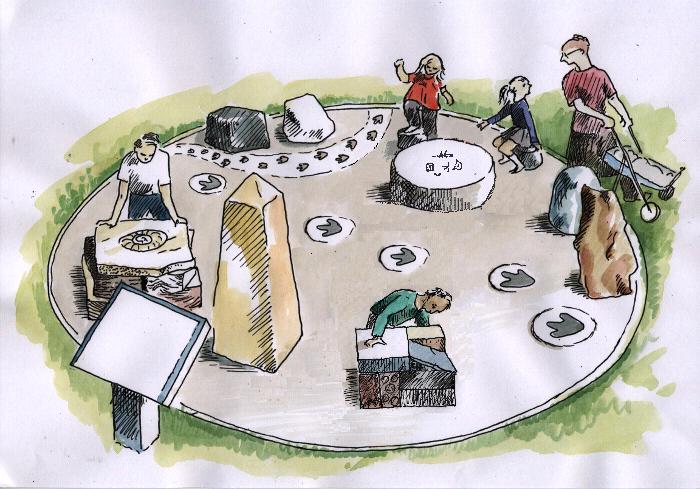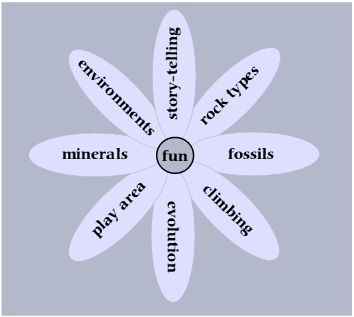


 |
 |
 |
Rock Circus Descriptions | Rock Circus Home
Rock descriptions
| Brief rock descriptions leaflet |
|
OBELISK
Box Ground Jurassic limestone made from 3 blocks from Hartham Quarry, Corsham, donated by Hanson Bath and Portland Stone. The rock is a sedimentary, oolitic limestone formed between 164 to 169 million years ago. It formed in a strongly evaporating shallow sea (15 - 20m). Tiny shell grains were picked up by strong currents, washed back and forth, gradually coated with concentric rings of calcium carbonate so forming tiny (c.1mm), round grains called ooliths or ooids. The rock contains lots of broken pieces of shell, mostly bivalves which are evidence of the high energy environment. When the ooliths and broken shells were too big to be held up by the currents, they fell to the sea bed and accumulated. Eventually, the sediment became cemented together with calcium carbonate from the sea water to form the rock you see today. Where was this bit of tectonic plate at the time? England was at approximately 30 degrees N , Mediterranean latitudes. The supercontinent of Pangaea was beginning to break up. Animals and plants at the time: The sea would have been clear and warm with ammonites and belemnites swimming around. The marine reptiles grew to enormous whale-like sizes. The Jurassic seas were filled with fierce pliosaurs as well as plesiosaurs and ichthysosaurs. Prehistoric fish were abundant, as were squids and prehistoric sharks. The skies were filled with pterosaurs and some prehistoric insects. The first small theropod dinosaurs began to evolve feathers; these later evolved into early birds. Gigantic herbivorous dinosaurs could not have evolved if they didn’t have a reliable source of food: the landmasses of the Jurassic were blanketed with thick, tasty coats of vegetation, including ferns, conifers, cycads, club mosses and horsetails. The first, mouse-sized early mammals kept a low profile, scurrying around at night so as not to get squashed under the feet of bigger dinosaurs, some of which were, of course, carnivorous. Stratigraphy: The limestone is part of the Combe Down Oolite, Bathonian, Middle Jurassic group. |
|
|
FOSSIL RUBBING BLOCK
Box Ground Jurassic limestone top on Hartham Stone Jurassic limestone base from Hartham Quarry, Corsham, donated by Hanson Bath and Portland Stone. The same notes apply to this block as for the obelisk. The Hartham Stone comes from a different rock stratum (layer) from the Box Ground; indicating a slightly different environment. Recesses were formed in the two slabs of Box Ground to a depth of 12mm and the bottom tooled to represent a sea bed. The fossil casts were placed in position, on 3 lumps of epoxy resin and adjusted so that the plane surface was at the correct level. The recess was now flooded with clear self-levelling epoxy of low viscosity such that it ran around and under the casts and bonded to the limestone. When set, the two slabs were fixed on to the base block. Details of the fossils in the fossil rubbings can be seen here and in the brief fossil rubbings leaflet. |
|
|
FOUR QUARRY BLOCKS
These tell the story of England’s movement through time from the southern hemisphere.
(1) Silurian lava
Andesite lava from Moon’s Hill Quarry, Stoke St. Michael, Somerset, donated by John Wainwright and Co. Ltd.
Where were we? England was south of the equator, at 30 -40 degrees S (where New Zealand is now). England and Wales were separated from Scotland and Northern Ireland at this time by an ocean. Plate movement caused us to join together by the end of the Silurian period. Animals and plants at the time: In the sea the Eurypterids or Sea Scorpions, were the dominant predator; one grew to 3m long, and had large claws for grabbing its prey. They were related to crabs, insects and spiders. There were coral reefs and fish with jaws, and bones had developed. You could have found trilobites, brachiopods and crinoids (sea lilies, animals related to sea urchins and star fish but looking like plants). On land, mosses and other primitive plants grew near the water’s edge. With lichens, they turned the rock into soil. Early insects lived among these mosses. Strange plants called Cooksonia evolved; they had stems, but no real leaves, (the first vascular tissue). Stratigraphy: The lava is in the Coalbrookdale Formation of the Silurian Period. It is poor in silica. |
|
|
(2) Old Red Sandstone
Where were we? England was south of the equator, at about 23.5 degrees S, tropic of Capricorn (roughly where the Kalahari desert is now). These deposits represent millions of years of erosion of the Caledonian mountains which were forming at the end of the Silurian period. Animals and plants at the time: The vertebrates were developing, gradually emerging on to land, and flourishing in seas and rivers. Vascular plants had also evolved and the first arthropods crawled, breathed air and began to fly. Animal and plant preservation was poor in this continental environment so there are no fossils to be seen in the rock. Stratigraphy: Devonian Brownstones Formation, Lower Old Red Sandstone. |
|
|
(3) Carboniferous limestone
Where were we? England was just south of the equator, at about 3 degrees S, (roughly where Padang, Sumatra is today).
Animals and plants at the time: In the seas there were lobe-finned fish, closely related to the first tetrapods and amphibians that invaded dry land. Sharks were common. As in preceding periods, small invertebrates like corals, crinoids and arthropods were plentiful.
Stratigraphy: Lower Carboniferous - Clifton Down Limestone Formation |
|
|
(4) New Red Sandstone
Where were we? England had now moved north of the equator, to about 23.5 degrees N, tropic of Cancer (roughly where the Sahara desert is now). All the Earth’s continents were joined together in Pangaea. There were no polar ice caps. These deposits represent millions of years of erosion of the Variscan mountains which were forming at the end of the Carboniferous and during the Permian periods. Animals and plants at the time: The Triassic is the first period after the mass extinction (c. 250 million years ago) when 95% species died. Mammal-like reptiles and the first dinosaurs evolved plus prehistoric crocodiles. The first mammals evolved in late Triassic times. The early marine reptiles, prehistoric fish and corals and cephalopods soon restocked the oceans. Pterosaurs joined the insects in the sky in the late Triassic. There was an explosion of plants on land, including cycads, ferns and gingko-like trees. There was not enough vegetation yet to support the huge herbivorous dinosaurs. Stratigraphy: Triassic sandstone from the Budleigh Salterton Pebble Beds Formation. |
|